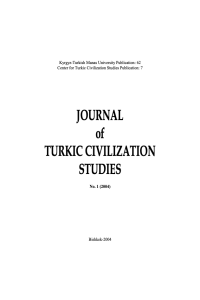Öz
In early periods there lived mainly Turkic, Mongol, Tungus, Manchu and Korean tribes in the northern and northeastern parts of the Asian Continent and they were neighbors to each other. According to linguistic studies of some researchers, those tribes in the origin were belonged to one linguistic family, i.e. to Altai Language Family and during the historical process they separated into several modern languages. However, today the relativity of Turkic, Mongol, Tungus and Manchu languages have been clarified thoroughly, and all of these language groups are accepted as “Altai language family” by world known linguists, the problem of dependency of the Korean to these group hasn’t been solved yet.
Although this is just a theory, the history of relations between the Turkic and Korean tribes started in the early times and it could be supported by the information not only from ancient manuscripts but also from archaeological and linguistic data. Among the written sources the Chinese chronicles of Han-shu (the 2nd c BC), Shi-ji (the 1st c AD), Pei-shih (the 7th c AD), Sui-shu (the 7th c AD) and Tang-shu (the 10th c AD) are very important ones. Besides this, the Orhun-Yenisei sources (the Old Turkic manuscripts of the 7th-9th c AD carved on stones) and the Tibetan manuscripts (the 8th-9th c AD) give a clear notion on this question.
Anahtar Kelimeler
Kaynakça
- N. Poppe, Introduction to Mongolian Comparative Studies.- Memoires de la Societe Finno- Ougrienne, 110, Helsinki, 1955; Introduction to Altaic Linguistics, Wiesbaden, 1965.
- Han-Woo Choi, “A Comparative Morphology of Altaic Languages – Deverbal Noun Suffixes”, International Journal of Central Asian Studies , vol. 7, Seoul, 2002, pp. 23-40.
- Z.V. Togan, Umumi Türk Tarihine Giriş, İstanbul, 1981, s. 15-16; Choi Han-Woo, “A Study of the ancient Turkic TARQAN”, International Journal of Central Asian Studies, Vol. 5, Seoul 2000, p. 104-110.
Öz
In early periods there lived mainly Turkic, Mongol, Tungus, Manchu and Korean tribes in the northern and northeastern parts of the Asian Continent and they were neighbors to each other. According to linguistic studies of some researchers, those tribes in the origin were belonged to one linguistic family, i.e. to Altai Language Family and during the historical process they separated into several modern languages. However, today the relativity of Turkic, Mongol, Tungus and Manchu languages have been clarified thoroughly, and all of these language groups are accepted as “Altai language family” by world known linguists, the problem of dependency of the Korean to these group hasn’t been solved yet.
Although this is just a theory, the history of relations between the Turkic and Korean tribes started in the early times and it could be supported by the information not only from ancient manuscripts but also from archaeological and linguistic data. Among the written sources the Chinese chronicles of Han-shu (the 2nd c BC), Shi-ji (the 1st c AD), Pei-shih (the 7th c AD), Sui-shu (the 7th c AD) and Tang-shu (the 10th c AD) are very important ones. Besides this, the Orhun-Yenisei sources (the Old Turkic manuscripts of the 7th-9th c AD carved on stones) and the Tibetan manuscripts (the 8th-9th c AD) give a clear notion on this question.
Anahtar Kelimeler
Kaynakça
- N. Poppe, Introduction to Mongolian Comparative Studies.- Memoires de la Societe Finno- Ougrienne, 110, Helsinki, 1955; Introduction to Altaic Linguistics, Wiesbaden, 1965.
- Han-Woo Choi, “A Comparative Morphology of Altaic Languages – Deverbal Noun Suffixes”, International Journal of Central Asian Studies , vol. 7, Seoul, 2002, pp. 23-40.
- Z.V. Togan, Umumi Türk Tarihine Giriş, İstanbul, 1981, s. 15-16; Choi Han-Woo, “A Study of the ancient Turkic TARQAN”, International Journal of Central Asian Studies, Vol. 5, Seoul 2000, p. 104-110.
Ayrıntılar
| Birincil Dil | İngilizce |
|---|---|
| Konular | Değişme, Azgelişmişlik ve Modernleşme Sosyolojisi |
| Bölüm | Araştırma Makalesi |
| Yazarlar | |
| Yayımlanma Tarihi | 30 Haziran 2004 |
| Yayımlandığı Sayı | Yıl 2004 Cilt: 1 Sayı: 1 |
Journal of Turkic Civilization Studies © 2022 by TUAUM is licensed under Attribution-NonCommercial 4.0 International
Journal of Turkic Civilization Studies by TUAUM is licensed under Attribution-NonCommercial 4.0 International


